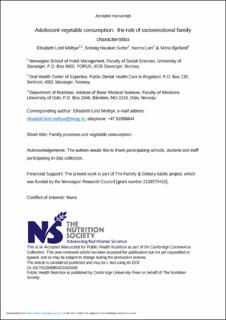| dc.contributor.author | Melbye, Elisabeth Lind | |
| dc.contributor.author | Hausken-Sutter, Solveig | |
| dc.contributor.author | Lien, Nanna | |
| dc.contributor.author | Bjelland, Mona | |
| dc.coverage.spatial | Norway | en_US |
| dc.date.accessioned | 2021-12-07T13:52:39Z | |
| dc.date.available | 2021-12-07T13:52:39Z | |
| dc.date.created | 2021-04-19T10:36:35Z | |
| dc.date.issued | 2021-04-16 | |
| dc.identifier.citation | Melbye, E.L., Hausken-Sutter, S., Lien, N. & Bjelland, M. (2021) Adolescent vegetable consumption: the role of socioemotional family characteristics. Public Health Nutrition, 24 (17), 5710-5719. | en_US |
| dc.identifier.issn | 1368-9800 | |
| dc.identifier.uri | https://hdl.handle.net/11250/2833185 | |
| dc.description.abstract | Objective:
To describe associations between adolescents’ frequency of vegetable consumption, food parenting practices and socioemotional family characteristics, and to explore potential mediated relationships that may contribute to an understanding of the family processes involved.
Design:
Cross-sectional survey among adolescents aged 13–15 years.
Setting:
A survey questionnaire including self-report measures on adolescents’ frequency of vegetable consumption, perceived food parenting practices (i.e. family dinner frequency, maternal/paternal healthy eating guidance (HEG), maternal/paternal social support for vegetable consumption) and socioemotional family characteristics (i.e. general family functioning and level of cohesion and conflict within the family) was distributed in a convenience sample of secondary school students.
Participants:
Four hundred forty students from five secondary schools in eastern Norway completed the questionnaire.
Results:
Results from multiple linear regression analysis revealed positive and statistically significant associations between adolescents’ frequency of vegetable consumption, maternal HEG and family cohesion. A partial indirect (mediated) association between family cohesion and adolescents’ frequency of vegetable consumption, working through maternal HEG, was also found.
Conclusions:
Results from the present study suggest that perceived family cohesion may influence adolescents’ frequency of vegetable consumption both directly and indirectly. However, there is a need for continued investigation of family-related factors influencing adolescent eating. In particular, the role of socioemotional family characteristics should be further scrutinised in future studies. | en_US |
| dc.language.iso | eng | en_US |
| dc.publisher | Cambridge University Press on behalf of The Nutrition Society | en_US |
| dc.subject | grønnsaker | en_US |
| dc.subject | sosioøkonomiske familietrekk | en_US |
| dc.subject | familieliv | en_US |
| dc.subject | kosthold | en_US |
| dc.subject | ungdommer | en_US |
| dc.title | Adolescent vegetable consumption: the role of socioemotional family characteristics | en_US |
| dc.type | Peer reviewed | en_US |
| dc.type | Journal article | en_US |
| dc.description.version | acceptedVersion | en_US |
| dc.rights.holder | © The Author(s), 2021 | en_US |
| dc.subject.nsi | VDP::Medisinske Fag: 700::Helsefag: 800::Ernæring: 811 | en_US |
| dc.source.pagenumber | 5710-5719 | en_US |
| dc.source.volume | 24 | en_US |
| dc.source.journal | Public Health Nutrition | en_US |
| dc.source.issue | 17 | en_US |
| dc.identifier.doi | 10.1017/S1368980021001658 | |
| dc.identifier.cristin | 1905016 | |
| cristin.ispublished | true | |
| cristin.fulltext | postprint | |
| cristin.qualitycode | 1 | |
